Luis Trenker (1892-1990) was an Austrian-Italian ski champion, mountain climber, architect, film director, and actor. He portrayed rugged, daring outdoorsmen in the 'Mountain Film'. This genre seemed to be created especially for him. Trenker's films glorified epic struggles such as colonization and wars for freedom, and were set against spectacular, usually mountainous landscapes.

Big German card by Ross Verlag. Photo: Tobis / Rota.

German postcard by Ross Verlag, no. 7314/2, 1932-1933. Photo: Deutsche Universal.
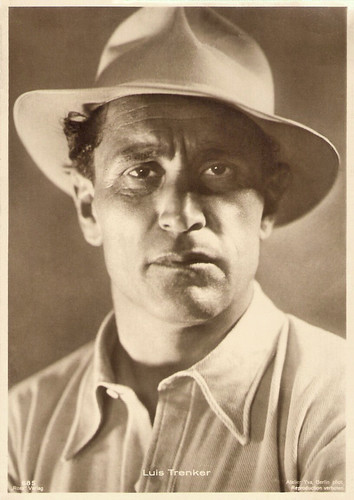
German postcard by Ross Verlag, no. 685. Photo: Atelier Yva, Berlin.
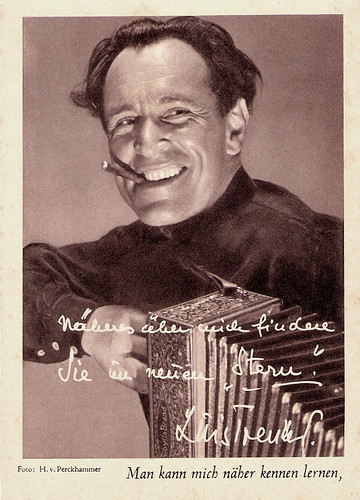
German promotion card by Deutscher Verlag for the new magazine Der Stern (now Stern) - founded in 1948. Photo: H. von Perckhammer.
Trenker was born as Alois Franz Trenker in 1892 in St. Ulrich in Southern Tyrol, then part of the Austrian Empire, now a part of Italy. He studied architecture in Vienna from 1912 until the outbreak of World War I.
He fought on the Austrian side, serving mainly as an officer in the Dolomites. He wrote several books based upon his war experiences, such as Sperrfort Rocca Alta. Der Heldenkampf eines Panzerwerkes/Fort Rocca Alta (1937) and Berge in Flammen/Mountains in Flames (1931). The latter was also made into a film in 1931.
After the war, he resumed his studies, and worked in Bolzano as an architect. His first contact with film came when he worked as an Alpine consultant on Wunder des Schneeschuhs/Wonders of the snowshoe (Arnold Fanck, 1920), a documentary about skiing at the beginning of the century.
Trenker gradually assumed more roles on the sets of Arnold Fanck’s films. The main actor in Fancks feature film Der Berg des Schicksals/Mountain of Destiny (Arnold Fanck, 1923) could not perform the stunts required, and so Fanck engaged Trenker for the leading role.
Thereafter they shot the films Der heilige Berg/The Holy Mountain (Arnold Fanck, 1926), Der grosse Sprung/The Great Leap (Arnold Fanck, 1927) both co-starring Leni Riefenstahl, and Der Kampf ums Matterhorn/Struggle for the Matterhorn (Mario Bonnard, Nunzio Malasomm, 1928).
By then Trenker was also directing, writing and starring in his own films and had abandoned his job as an architect. He married Hilde Bleichert, with whom he would have four children.
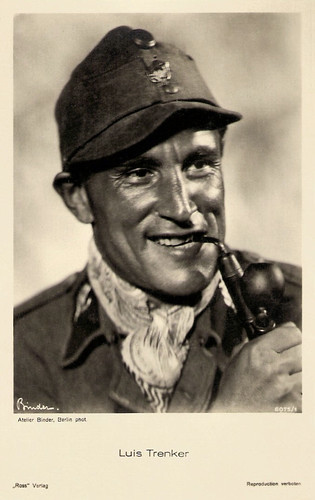
German postcard by Ross Verlag, no. 6075/1, 1931-1932. Photo: Atelier Binder, Berlin.
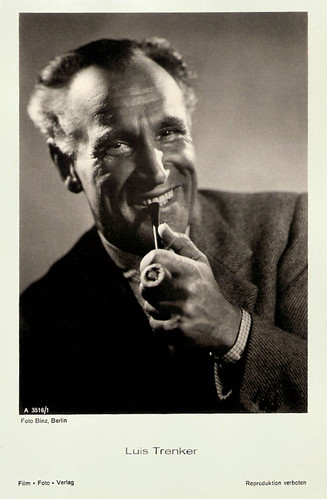
German postcard by Film-Foto-Verlag, no. A 3516/1, 1941-1944. Photo: Tita Binz, Berlin.

German postcard by Film-Foto-Verlag, no. A 3673/1, 1941-1944. Photo: Tita Binz, Berlin.

German postcard by Ross Verlag, no. G 50. Photo: Ufa / Tita Binz. Sadly the edges of this card were cut off by a former owner.
Luis Trenker obtained the top of his film career with an impressive series of successful productions: Der Sohn der weissen Berge/The Son of the White Mountain (Mario Bonnard, Luis Trenker, 1930), Berge in Flammen/Mountains on Fire (Karl Hartl, Luis Trenker, 1931), Der Rebell/The Rebel (Kurt Bernhardt/Curtis Bernhardt, Edwin H. Knopf, Luis Trenker, 1932), Der verlorene Sohn/The Prodigal Son (Luis Trenker, 1934), Der Kaiser von Kalifornien/The Emperor of California (Luis Trenker, 1936), Condottieri/Giovanni de Medici: The Leader (Luis Trenker, 1937), Der Berg ruft!/The Mountain Calls (Luis Trenker, 1937) and Liebesbriefe aus dem Engadin/Love Letters from the Engadin (Werner Klingler, Luis Trenker, 1938).
These film got him a unique place in the world of the Mountain Film. The main theme of Trenker's work was the idealization of people's connection with their homeland, and pointing out the decadence of city life. This is most clearly visible in his Der verlorene Sohn/The Prodigal Son about the trials and tribulations of a German who emigrates to the US during the Great Depression. In 1934 Trenker worked in Hollywood for this film, but soon he returned to Europe.
Immediately after WW2, Der verlorene Sohn/The Prodigal Son was banned in the western part of Germany by the US military government because it was considered to be 'anti-American'. In the eastern part of Germany the film was banned by the Soviet military government because it was considered to advertise for the US and the American way of life.
The Nazi propagandists seized upon the nationalistic elements of Trenker's work, but his film Der Feuerteufel/The Fire-Devil (Luis Trenker, 1940) displeased Propaganda Minister Josef Goebbels. Trenker was barred from directing and he was allowed to act only in films by second-rate directors.
He eventually moved to Rome to avoid further governmental pressure. There he produced and co-directed a documentary about Pope Pius XII, Pastor Angelicus (Romolo Marcellini, Luis Trenker, 1942) and directed Monte Miracolo (Luis Trenker, 1945). After this film, he returned to Bolzano and quit film making.
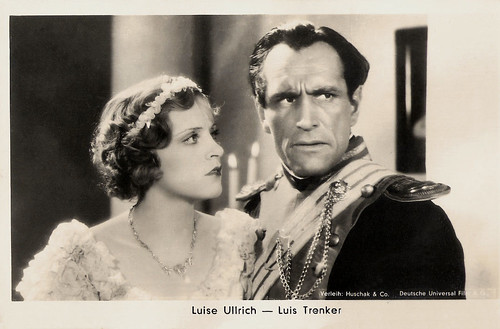
German postcard. Photo: Verleih Muschak & Co. / Deutsche Universal Film. Publicity still for Der Rebell (1932) with Luise Ullrich.
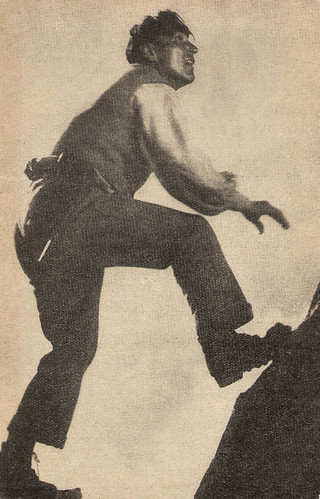
Dutch postcard by H.W. Overeem. Photo: still from Der Rebell (1932).
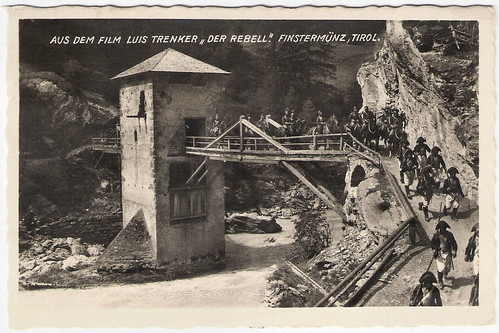
German postcard. Sent by mail in Germany in 1939. Photo: Peter Ottl, Nauders, Tirol. Still for Der Rebell (1932).
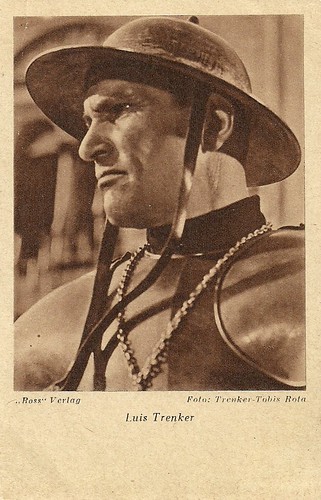
German postcard by Ross Verlag. Photo: Trenker / Tobis / Rota. Luis Trenker as Giovanni de' Medici in the Italian histroical film Condottieri (Luis Trenker, 1937).
The style Luis Trenker had developed in the 1930s was more than just nationalistic, folkloristic and heroic clichés. Many critics have praised the visual expressiveness of Trenker's films.
His impersonation of a hungry, down ridden immigrant in depression time New York was regarded as one of the seminal scenes for future Italian Neorealism by the likes of Roberto Rossellini.
After the war Trenker was accused of fascist opportunism, but eventually the charges were dropped. In this period he merely made short documentaries, but at the end of the 1950s he had a short comeback with his films Prigioniero della montagna/Flucht in die Dolomiten/Escape in the Dolomites (Luis Trenker, 1955), Von der Liebe besiegt/Defeated by love (Luis Trenker, 1956) with Marianne Hold, Wetterleuchten um Maria/Lightning around Maria (Luis Trenker, 1957) again starring Marianne Hold, and Sein bester Freund/His Best Friend (Luis Trenker, 1962).
By 1965 he had switched mainly to the documentary form, focusing upon the Austrian province of Tyrol. In 1966 he worked for TV with the ski champion Toni Sailer at the series Luftsprünge/Air jumps (1969-1970).
He published his memories, Alles gut gegangen (Everything Went Well). In 1990 Luis Trenker died at the age of 97.
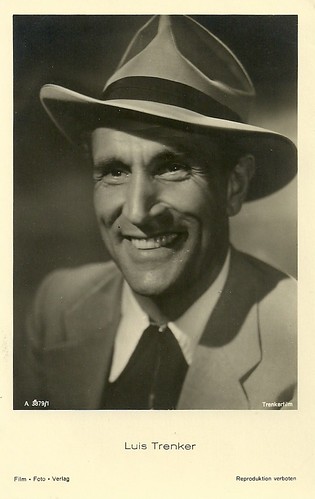
German postcard by Film-Foto-Verlag, no. A 3879/1, 1941-1944. Photo: Trenkerfilm.
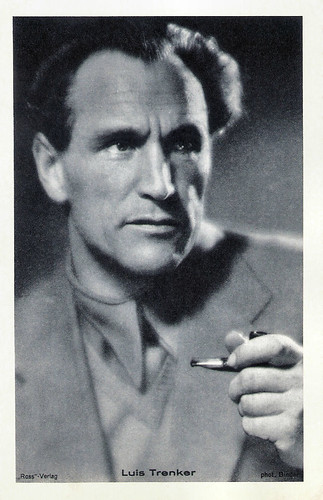
German postcard by Ross-Verlag. Photo: Binder. Collection: Egbert Barten.
Sources: Thomas Staedeli (Cyranos), Rudi Polt (IMDb), Luistrenker.com (German), Wikipedia, and IMDb.

Big German card by Ross Verlag. Photo: Tobis / Rota.

German postcard by Ross Verlag, no. 7314/2, 1932-1933. Photo: Deutsche Universal.

German postcard by Ross Verlag, no. 685. Photo: Atelier Yva, Berlin.

German promotion card by Deutscher Verlag for the new magazine Der Stern (now Stern) - founded in 1948. Photo: H. von Perckhammer.
The Holy Mountain
Trenker was born as Alois Franz Trenker in 1892 in St. Ulrich in Southern Tyrol, then part of the Austrian Empire, now a part of Italy. He studied architecture in Vienna from 1912 until the outbreak of World War I.
He fought on the Austrian side, serving mainly as an officer in the Dolomites. He wrote several books based upon his war experiences, such as Sperrfort Rocca Alta. Der Heldenkampf eines Panzerwerkes/Fort Rocca Alta (1937) and Berge in Flammen/Mountains in Flames (1931). The latter was also made into a film in 1931.
After the war, he resumed his studies, and worked in Bolzano as an architect. His first contact with film came when he worked as an Alpine consultant on Wunder des Schneeschuhs/Wonders of the snowshoe (Arnold Fanck, 1920), a documentary about skiing at the beginning of the century.
Trenker gradually assumed more roles on the sets of Arnold Fanck’s films. The main actor in Fancks feature film Der Berg des Schicksals/Mountain of Destiny (Arnold Fanck, 1923) could not perform the stunts required, and so Fanck engaged Trenker for the leading role.
Thereafter they shot the films Der heilige Berg/The Holy Mountain (Arnold Fanck, 1926), Der grosse Sprung/The Great Leap (Arnold Fanck, 1927) both co-starring Leni Riefenstahl, and Der Kampf ums Matterhorn/Struggle for the Matterhorn (Mario Bonnard, Nunzio Malasomm, 1928).
By then Trenker was also directing, writing and starring in his own films and had abandoned his job as an architect. He married Hilde Bleichert, with whom he would have four children.

German postcard by Ross Verlag, no. 6075/1, 1931-1932. Photo: Atelier Binder, Berlin.

German postcard by Film-Foto-Verlag, no. A 3516/1, 1941-1944. Photo: Tita Binz, Berlin.

German postcard by Film-Foto-Verlag, no. A 3673/1, 1941-1944. Photo: Tita Binz, Berlin.

German postcard by Ross Verlag, no. G 50. Photo: Ufa / Tita Binz. Sadly the edges of this card were cut off by a former owner.
The Prodigal Son
Luis Trenker obtained the top of his film career with an impressive series of successful productions: Der Sohn der weissen Berge/The Son of the White Mountain (Mario Bonnard, Luis Trenker, 1930), Berge in Flammen/Mountains on Fire (Karl Hartl, Luis Trenker, 1931), Der Rebell/The Rebel (Kurt Bernhardt/Curtis Bernhardt, Edwin H. Knopf, Luis Trenker, 1932), Der verlorene Sohn/The Prodigal Son (Luis Trenker, 1934), Der Kaiser von Kalifornien/The Emperor of California (Luis Trenker, 1936), Condottieri/Giovanni de Medici: The Leader (Luis Trenker, 1937), Der Berg ruft!/The Mountain Calls (Luis Trenker, 1937) and Liebesbriefe aus dem Engadin/Love Letters from the Engadin (Werner Klingler, Luis Trenker, 1938).
These film got him a unique place in the world of the Mountain Film. The main theme of Trenker's work was the idealization of people's connection with their homeland, and pointing out the decadence of city life. This is most clearly visible in his Der verlorene Sohn/The Prodigal Son about the trials and tribulations of a German who emigrates to the US during the Great Depression. In 1934 Trenker worked in Hollywood for this film, but soon he returned to Europe.
Immediately after WW2, Der verlorene Sohn/The Prodigal Son was banned in the western part of Germany by the US military government because it was considered to be 'anti-American'. In the eastern part of Germany the film was banned by the Soviet military government because it was considered to advertise for the US and the American way of life.
The Nazi propagandists seized upon the nationalistic elements of Trenker's work, but his film Der Feuerteufel/The Fire-Devil (Luis Trenker, 1940) displeased Propaganda Minister Josef Goebbels. Trenker was barred from directing and he was allowed to act only in films by second-rate directors.
He eventually moved to Rome to avoid further governmental pressure. There he produced and co-directed a documentary about Pope Pius XII, Pastor Angelicus (Romolo Marcellini, Luis Trenker, 1942) and directed Monte Miracolo (Luis Trenker, 1945). After this film, he returned to Bolzano and quit film making.

German postcard. Photo: Verleih Muschak & Co. / Deutsche Universal Film. Publicity still for Der Rebell (1932) with Luise Ullrich.

Dutch postcard by H.W. Overeem. Photo: still from Der Rebell (1932).

German postcard. Sent by mail in Germany in 1939. Photo: Peter Ottl, Nauders, Tirol. Still for Der Rebell (1932).

German postcard by Ross Verlag. Photo: Trenker / Tobis / Rota. Luis Trenker as Giovanni de' Medici in the Italian histroical film Condottieri (Luis Trenker, 1937).
Visual Expressiveness
The style Luis Trenker had developed in the 1930s was more than just nationalistic, folkloristic and heroic clichés. Many critics have praised the visual expressiveness of Trenker's films.
His impersonation of a hungry, down ridden immigrant in depression time New York was regarded as one of the seminal scenes for future Italian Neorealism by the likes of Roberto Rossellini.
After the war Trenker was accused of fascist opportunism, but eventually the charges were dropped. In this period he merely made short documentaries, but at the end of the 1950s he had a short comeback with his films Prigioniero della montagna/Flucht in die Dolomiten/Escape in the Dolomites (Luis Trenker, 1955), Von der Liebe besiegt/Defeated by love (Luis Trenker, 1956) with Marianne Hold, Wetterleuchten um Maria/Lightning around Maria (Luis Trenker, 1957) again starring Marianne Hold, and Sein bester Freund/His Best Friend (Luis Trenker, 1962).
By 1965 he had switched mainly to the documentary form, focusing upon the Austrian province of Tyrol. In 1966 he worked for TV with the ski champion Toni Sailer at the series Luftsprünge/Air jumps (1969-1970).
He published his memories, Alles gut gegangen (Everything Went Well). In 1990 Luis Trenker died at the age of 97.

German postcard by Film-Foto-Verlag, no. A 3879/1, 1941-1944. Photo: Trenkerfilm.

German postcard by Ross-Verlag. Photo: Binder. Collection: Egbert Barten.
Sources: Thomas Staedeli (Cyranos), Rudi Polt (IMDb), Luistrenker.com (German), Wikipedia, and IMDb.
No comments:
Post a Comment